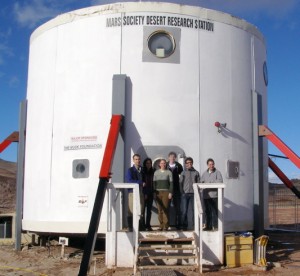The desert here is even more beautiful than I imagined. We were awestruck, driving in from the highway on a dirt road that passed by hills and cliffs laminated not only in structure but also vivid colors: red, cream, gold, white. Puddles in the road cupped dazzling pieces of the sky, reflecting white-blue radiance to light our way to the Hab. We passed a series of smooth reddish hills topped by thick yellow blocks of a more durable sandstone. Each corner we turned revealed new, gorgeous views that had us itching to get out and explore!
We arrived at the Hab about 1 p.m. Crew 88 was waiting for us and gave us a very warm welcome. They walked us through all of the critical Hab systems and the proper use of the EVA suits and ATVs. They’ve put together a stack of laminated guides to every aspect of Hab life. Lucky us! We stood around, all smiles, for some crew photos in front of the Hab—and then Crew 88 drove off in gleeful anticipation of showers and real food, and we retired to the Hab—now “ours”—to settle in.Our first challenge struck almost immediately. Darrel discovered that his coat was missing—presumably taken away inadvertently by Crew 88. Brian and Darrel hopped into the “pressurized rover” (a Ford Explorer) and took off after them. Carla, LuÃs, Mike, and I remained in the Hab to begin cleaning the area and storing our belongings and the pile of food we’d picked up at the Bull Mountain Market. We inventoried the existing pantry items and found that we’d picked up duplicates of several things. But really, can you ever have too much tinned corned beef?
We had just finished when Darrel and Brian returned, having successfully caught up with Crew 88 and retrieved Darrel’s coat. In the meantime, the four of us Hab-bound had prepared a late lunch by reconstituting freeze-dried Alfredo Shrimp Pasta. Quite a tasty meal, combined with some “shelf-stable” bread, when it’s 4 p.m. and you haven’t eaten since breakfast! We then organized ourselves and went out with flashlights to compile information for the Engineering report: reading water levels, battery charges, propane levels, and so on. The half-moon was high in the sky, so incredibly bright that we turned off our flashlights to walk out to the generator station. A great sweep of stars was spilled across the sky, feathered and broken by clouds that were white with distilled moonlight. We spotted Orion, Cassiopoeia, and (of course!) Mars glowing a steady, brilliant red low in the eastern sky.
It was a lovely end to an exciting day. Tomorrow we’ll be up early, with a long list of things to do—among them, starting up the ATVs (not an easy or simple task, it seems!) and learning how to ride them before donning suits for our first EVAs.


